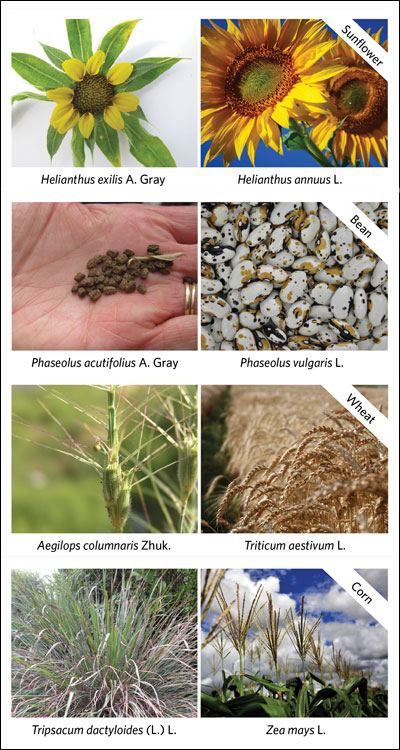 | ||
Representative species Oryza rufipogon, Pitseed Goosefoot, Hordeum arizonicum | ||
Crop wild relatives origins
A crop wild relative (CWR) is a wild plant closely related to a domesticated plant, whose geographic origins can be traced to regions known as Vavilov Centers (named for the pioneering botanist Nikolai Vavilov). It may be a wild ancestor of the domesticated plant, or another closely related taxon.
Contents
- Crop wild relatives origins
- Crop wild relatives
- Overview
- Conservation of crop wild relatives
- Grains
- Vegetables
- Fruits
- Oilseeds
- Pulses
- Tubers
- References
Crop wild relatives
Overview
The wild relatives of crop plants constitute an increasingly important resource for improving agricultural production and for maintaining sustainable agro-ecosystems. With the advent of climate change and greater ecosystem instability CWRs are likely to prove a critical resource in ensuring food security for the new millennium. It was Nikolai Vavilov, the Russian botanist who first realized the importance of crop wild relatives in the early 20th century. Genetic material from CWRs has been utilized by humans for thousands of years to improve the quality and yield of crops. Farmers have used traditional breeding methods for millennia, wild maize (Zea mexicana) is routinely grown alongside maize to promote natural crossing and improve yields. More recently, plant breeders have utilised CWR genes to improve a wide range of crops like rice (Oryza sativa), tomato (Solanum lycopersicum) and grain legumes.
CWRs have contributed many useful genes to crop plants, and modern varieties of most major crops now contain genes from their wild relatives.Therefore CWRs are wild plants related to socio-economically important species including food, fodder and forage crops, medicinal plants, condiments, ornamental, and forestry species, as well as plants used for industrial purposes, such as oils and fibres, and to which they can contribute beneficial traits. A CWR can be defined as "... a wild plant taxon that has an indirect use derived from its relatively close genetic relationship to a crop...”
Conservation of crop wild relatives
CWRs are essential components of natural and agricultural ecosystems and hence are indispensable for maintaining ecosystem health. Their conservation and sustainable use is very important for improving agricultural production, increasing food security, and maintaining a healthy environment.
The natural populations of many CWRs are increasingly at risk. They are threatened by habitat loss through the destruction and degradation of natural environment or their conversion to other uses. Deforestation is leading to the loss of many populations of important wild relatives of fruit, nut, and industrial crops. Populations of wild relatives of cereal crops that occur in arid or semi-arid lands are being severely reduced by over grazing and resulting desertification. The growing industrialization of agriculture is drastically reducing the occurrence of CWRs within the traditional agro-ecosystems. The wise conservation and use of CWRs are essential elements for increasing food security, eliminating poverty, and maintaining the environment.
In 2016, 29% of wild relative plant species were completely missing from the world’s genebanks, with a further 24% represented by fewer than 10 samples. Over 70% of all crop wild relative species worldwide were in urgent need of further collecting to improve their representation in genebanks, and over 95% were insufficiently represented with regard to the full range of geographic and ecological variation in their native distributions. While the most critical priorities for further collecting were found in the Mediterranean and Near East, Western and Southern Europe, Southeast and East Asia, and South America, crop wild relatives insufficiently represented in genebanks are distributed across almost all countries worldwide.
Grains
Vegetables
Note: Many different vegetables share one common ancestor, particularly in the Brassica family and plants. Many vegetables are also hybrids of different species, again this is particularly true of Brassicas.
